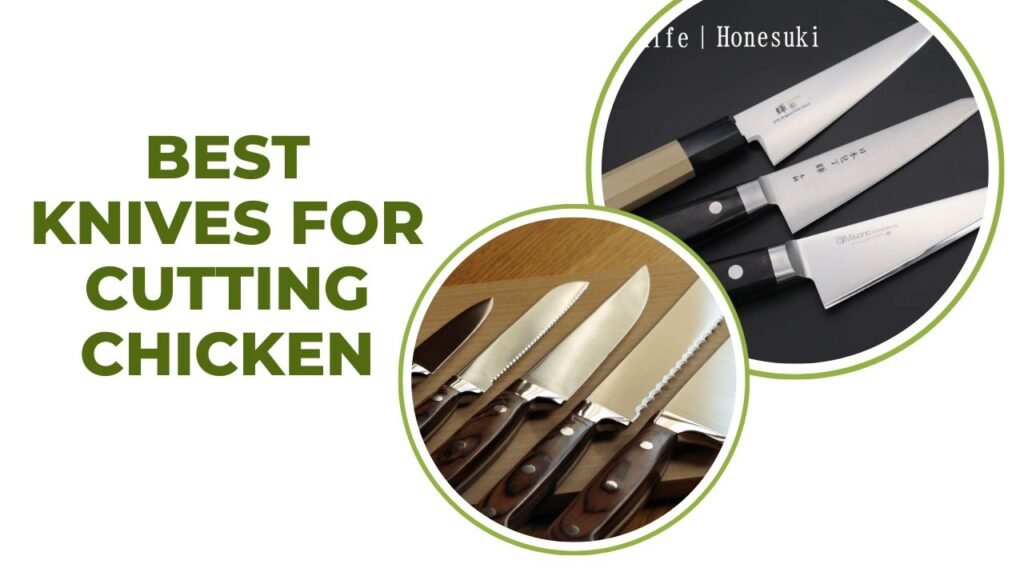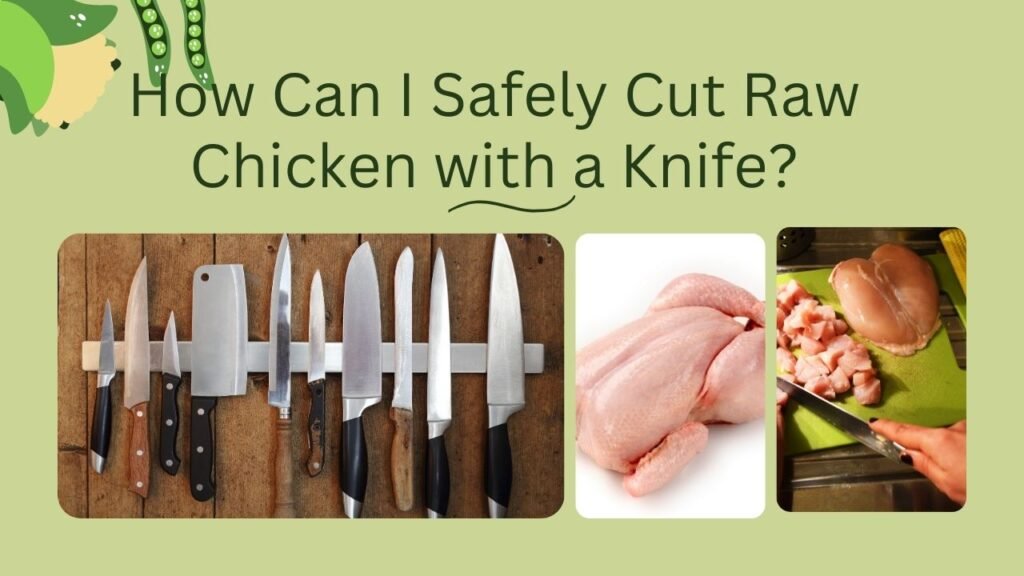Imagine this: You’re in the middle of preparing a delicious chicken dinner, but as you reach for your knife, you hesitate, worried about handling raw poultry safely. The question arises: How can I safely cut raw chicken with a knife? Whether you’re a seasoned chef or a kitchen novice, mastering the art of safely cutting raw chicken is essential for both delicious meals and maintaining a hygienic kitchen. Let’s explore the best practices, tools, and techniques to ensure your chicken preparation is both safe and efficient.
Why Safe Cutting Matters
Have you ever wondered why kitchen safety is so emphasized when handling raw chicken? It’s not just about avoiding accidents; it’s also crucial for preventing foodborne illnesses. Raw chicken can harbor harmful bacteria like Salmonella and Campylobacter, which can cause serious health issues if not handled properly.
Key Reasons to Prioritize Safety:
- Prevent Cross-Contamination: Avoid spreading bacteria to other foods and surfaces.
- Ensure Food Safety: Proper handling reduces the risk of foodborne illnesses.
- Maintain Knife Hygiene: A clean knife ensures better cuts and safer food preparation.
- Protect Yourself: Prevent cuts and injuries while handling sharp kitchen tools.
Essential Tools for Cutting Raw Chicken Safely
Before diving into how to safely cut raw chicken with a knife, it’s important to gather the right tools. Using the appropriate knives and equipment not only makes the job easier but also enhances safety.
Must-Have Kitchen Tools:
- Sharp Chef’s Knife: A well-maintained, sharp knife is crucial for precise and safe cuts.
- Cutting Board: Preferably separate boards for raw meat and other foods to prevent cross-contamination.
- Kitchen Shears: Useful for trimming fat and cutting through joints.
- Protective Gloves: To protect your hands from cuts and reduce contact with raw meat.
- Sanitizing Solution: For cleaning knives and surfaces after handling raw chicken.
Choosing the Right Knife: What Makes a Good Knife for Chicken?
When it comes to How can I safely cut raw chicken with a knife, the type of knife you use plays a significant role. Not all knives are created equal, and selecting the right one can make the process smoother and safer.

Best Knives for Cutting Chicken:
- Chef’s Knife: Versatile and essential for most kitchen tasks, including slicing and chopping chicken.
- Features: Broad blade, sharp edge, balanced weight.
- Advantages: Excellent control and precision.
- Boning Knife: Ideal for removing bones and making intricate cuts.
- Features: Thin, flexible blade with a sharp point.
- Advantages: Precision in navigating around bones and joints.
- Utility Knife: A mid-sized knife that’s great for smaller tasks.
- Features: Smaller blade than a chef’s knife, versatile for various cuts.
- Advantages: Easier to handle for detailed work.
Personal Opinion:
I personally find a sharp chef’s knife to be indispensable. Its versatility and control make it perfect for safely cutting raw chicken, whether you’re trimming, slicing, or portioning.
Step-by-Step Guide: How to Safely Cut Raw Chicken with a Knife
Mastering how to safely cut raw chicken with a knife involves following a series of steps that prioritize hygiene and efficiency. Here’s a detailed guide to help you through the process.
1. Prepare Your Workspace
Start by setting up a clean and organized workspace. A clutter-free area reduces the risk of accidents and cross-contamination.
- Clean Surface: Wipe down your cutting board and countertops with a sanitizing solution.
- Organize Tools: Have your knife, shears, and other tools within easy reach.
- Separate Boards: Use separate cutting boards for raw chicken and other foods like vegetables or bread.
2. Wash Your Hands and Tools
Before handling raw chicken, ensure your hands and tools are clean to prevent the spread of bacteria.
- Hand Washing: Wash your hands thoroughly with soap and water for at least 20 seconds.
- Clean Tools: Make sure your knife and cutting board are sanitized.
3. Inspect the Chicken
Examine the chicken for any irregularities or excess fat that might need trimming before cutting.
- Remove Packaging: Take the chicken out of its packaging and discard any packaging materials.
- Trim Excess Fat: Use kitchen shears or a knife to trim away any excess fat or loose skin.
4. Position the Chicken on the Cutting Board
Place the chicken breast-side up on a stable cutting board. Ensure it lies flat to make cutting easier and safer.
5. Make Initial Cuts
Begin by making clean, controlled cuts to divide the chicken into manageable sections.
- Separate the Legs: Cut through the joint where the leg meets the body using a smooth, steady motion.
- Detach the Wings: Similarly, cut through the joint to remove the wings.
- Slice the Breast: Starting at the top, make a deep cut along the breastbone to separate the breast meat from the carcass.
6. Portion the Chicken
Once the chicken is divided into basic sections, you can further portion it as needed for your recipe.
- Breast Portions: Slice the breast meat into even, manageable pieces.
- Thighs and Drumsticks: Trim any remaining fat and separate the thighs from the drumsticks if desired.
7. Handle and Store Properly
After cutting, handle the chicken properly to maintain safety and quality.
- Immediate Cooking or Storage: Cook the chicken immediately or store it in the refrigerator or freezer.
- Clean Up: Wash all knives, cutting boards, and surfaces with hot, soapy water or a sanitizing solution.
Pro Tip:
Always cut away from your body and use a stable grip on the chicken to prevent slips and ensure smooth, even cuts.
Safety Tips for Cutting Raw Chicken
Ensuring safety while cutting raw chicken is paramount. Here are some essential tips to keep in mind:
1. Keep Knives Sharp
A sharp knife reduces the effort needed and minimizes the risk of slipping.
- Regular Sharpening: Use a honing steel or sharpening tool regularly to maintain the knife’s edge.
- Proper Storage: Store knives in a safe place to keep them sharp and prevent accidents.
2. Use Proper Cutting Techniques
Employing the right techniques can enhance safety and efficiency.
- Stable Grip: Hold the knife firmly with your dominant hand and use a claw grip with your non-dominant hand to guide the chicken.
- Controlled Motion: Use smooth, controlled movements rather than jerky or forceful cuts.
3. Avoid Cross-Contamination
Preventing cross-contamination is crucial for food safety.
- Separate Tools: Use different cutting boards for raw chicken and other ingredients.
- Immediate Cleaning: Clean all surfaces and tools immediately after handling raw chicken.
4. Wear Protective Gear
Using gloves can add an extra layer of protection.
- Food-Grade Gloves: Wear disposable gloves to protect your hands and reduce the risk of contamination.
- Non-Slip Grip: Ensure gloves fit well and provide a good grip on the chicken and tools.
5. Proper Storage
Store raw chicken correctly to maintain freshness and prevent bacterial growth.
- Refrigeration: Keep raw chicken refrigerated at or below 40°F (4°C).
- Freezing: Freeze chicken in airtight containers if not using within a few days.
Common Mistakes to Avoid
Even with the best intentions, some common mistakes can compromise safety and the quality of your chicken cuts.
1. Using a Dull Knife
A dull knife can slip and cause accidents, leading to uneven cuts and potential injuries.
- Solution: Regularly sharpen your knives and replace them if they lose their edge.
2. Cutting Too Quickly
Rushing the cutting process increases the risk of mistakes and accidents.
- Solution: Take your time and use steady, controlled motions to ensure precision and safety.
3. Not Securing the Cutting Board
An unstable cutting board can lead to slips and accidents.
- Solution: Place a damp towel underneath the cutting board to keep it steady.
4. Ignoring Hand Positioning
Improper hand positioning can result in cuts and injuries.
- Solution: Use the claw grip with your non-dominant hand to guide the chicken safely.
5. Cross-Contamination
Failing to prevent cross-contamination can lead to foodborne illnesses.
- Solution: Use separate cutting boards and utensils for raw chicken and other foods.
Comparing Knife Types for Cutting Raw Chicken
Choosing the right knife involves understanding the strengths and weaknesses of each type. Here’s a quick comparison to help you decide:
| Knife Type | Pros | Cons |
|---|---|---|
| Chef’s Knife | Versatile, excellent control and precision | Requires regular maintenance |
| Boning Knife | Flexible, precise around bones | Limited use outside meat preparation |
| Utility Knife | Manageable size, versatile | Not as specialized as other knives |
| Butcher Knife | Heavy-duty, excellent for cutting through joints | Can be bulky and require more effort |
| Santoku Knife | Great for slicing and dicing, sharp edge | Less effective for heavy-duty tasks |
Personal Opinion:
While a chef’s knife is my go-to for most tasks, a boning knife is indispensable when dealing with bones and joints in chicken. Having a variety of knives ensures you’re prepared for any cutting challenge.

Delicious Recipes You Can Make with Properly Cut Chicken
Once you’ve mastered How can I safely cut raw chicken with a knife, it’s time to put those skills to good use with some mouth-watering recipes.
1. Classic Chicken Alfredo
A creamy and comforting dish that’s perfect for any occasion.
Ingredients:
- 2 chicken breasts, cut into strips
- 2 tbsp olive oil
- 3 cloves garlic, minced
- 1 cup heavy cream
- 1 cup grated Parmesan cheese
- Salt and pepper to taste
- Cooked fettuccine pasta
- Fresh parsley, chopped
Instructions:
- Season Chicken: Season the chicken strips with salt and pepper.
- Cook Chicken: Heat olive oil in a large skillet over medium heat. Add chicken and cook until golden and cooked through, about 5-7 minutes.
- Make Alfredo Sauce: In the same skillet, add garlic and sauté for 1 minute. Pour in heavy cream and bring to a simmer. Stir in Parmesan cheese until melted and smooth.
- Combine: Add the cooked chicken and fettuccine to the sauce, tossing to coat evenly.
- Serve: Garnish with fresh parsley and additional Parmesan if desired.
2. Chicken Stir-Fry
A quick and healthy option packed with vegetables and flavor.
Ingredients:
- 2 chicken breasts, cut into bite-sized pieces
- 2 tbsp soy sauce
- 1 tbsp oyster sauce
- 1 tsp cornstarch
- 2 tbsp vegetable oil
- 1 bell pepper, sliced
- 1 carrot, julienned
- 1 cup broccoli florets
- 2 cloves garlic, minced
- 1 tsp ginger, grated
- Cooked rice or noodles
Instructions:
- Marinate Chicken: In a bowl, combine soy sauce, oyster sauce, and cornstarch. Add chicken pieces and marinate for 15 minutes.
- Cook Chicken: Heat vegetable oil in a large skillet or wok over high heat. Add chicken and stir-fry until browned and cooked through, about 5-7 minutes. Remove and set aside.
- Stir-Fry Vegetables: In the same skillet, add more oil if needed. Add bell pepper, carrot, and broccoli. Stir-fry for 3-4 minutes until tender-crisp.
- Add Aromatics: Add garlic and ginger, sautéing for another minute.
- Combine: Return the chicken to the skillet and toss everything together. Cook for an additional 2 minutes.
- Serve: Serve hot over cooked rice or noodles.
Quick Recipe Ideas
| Recipe | Main Ingredients | Preparation Time | Difficulty |
|---|---|---|---|
| Classic Chicken Alfredo | Chicken breasts, heavy cream, Parmesan | 25 minutes | Easy |
| Chicken Stir-Fry | Chicken breasts, vegetables, soy sauce | 20 minutes | Easy |
| Lemon Herb Grilled Chicken | Chicken thighs, lemon, herbs | 15 minutes | Easy |
| Chicken Tacos | Shredded chicken, tortillas, toppings | 10 minutes | Easy |
Frequently Asked Questions
1. Can I use any type of knife to cut raw chicken safely?
While you can use various knives, a sharp chef’s knife or boning knife is recommended for precision and safety. These knives offer better control and make the cutting process smoother.
2. How do I prevent my knife from slipping while cutting raw chicken?
Ensure your knife is sharp and handle it with a firm grip. Stabilize the chicken on a secure cutting board and use a claw grip with your non-dominant hand to guide the meat safely.
3. What should I do if I accidentally cut myself while handling raw chicken?
Immediately wash the wound with soap and water, apply an antiseptic, and cover it with a clean bandage. Seek medical attention if the cut is deep or if you notice signs of infection.
4. How can I ensure my chicken is fully cooked after cutting?
Use a meat thermometer to check the internal temperature, ensuring it reaches at least 165°F (74°C). Alternatively, cut into the thickest part of the meat to ensure the juices run clear.
5. Is it safe to reuse the same knife for raw chicken and other foods?
No, reusing the same knife can lead to cross-contamination. Always thoroughly wash and sanitize knives and cutting boards after handling raw chicken before using them for other foods.
Conclusion
Mastering how can I safely cut raw chicken with a knife is an essential skill that enhances both your cooking efficiency and kitchen safety. By choosing the right knife, following proper techniques, and adhering to safety measures, you can prepare delicious and safe meals with confidence. Remember to keep your tools sharp, maintain a clean workspace, and handle raw chicken with care to prevent cross-contamination. Whether you’re preparing a simple weeknight dinner or a festive feast, these tips will ensure your chicken dishes are both delicious and safe to enjoy. So, grab your favorite knife, follow these steps, and carve your way to culinary success!


